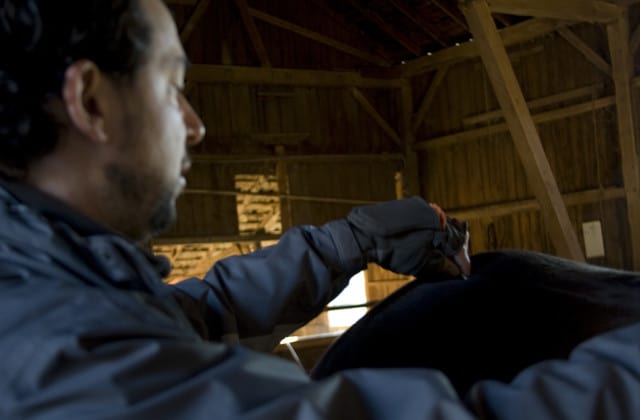
By Valerie LK Martin




When we humans are in pain, it is not difficult to know it. We complain, moan, groan and bellyache.
When animals are in pain or hurt, it can sometimes be hard to tell. They might go quiet and distant. They might suddenly kick or snap at you. Usually, these are good signs that something is wrong.
What is even more difficult is to know when they are improving. One diagnostic tool that also treats is acupuncture.
Most people are familiar with the 5,000-year-old technique for humans. What is less familiar is that its use on animals dates back 3,000 years.
Dr. Marvin Cain brought it to the United States in the early 1970s, according to acuhealthllc.com, a website for an acupuncture facility run by Cain’s daughter, Brett Cain, R.N., M.Ac., M.Q.P. in Florence, Ky.
Marvin Cain was encouraged by a friend to explore acupuncture, unknown in North America at that time, the website stated. With a healthy skepticism, he attended a seminar being given by a visiting Chinese doctor with the aim of discrediting it. But he could not.
Marvin Cain traveled to China and studied human acupuncture, brought it back to the U.S., pioneered veterinary acupuncture, and co-founded the International Veterinary Acupuncture Society, according to the website.
In 1974-75, the first acupuncture course was held in Cincinnati. Today, IVAS has more than 1,800 veterinarian practitioners, according to its website.
One such practitioner is Brett Ellis, D.M.V., of Veterinary Associates in Xenia, who is certified by the IVAS. He mostly performs the service on horses, but has used it on dogs, cats and other pets.
“The chi is the flow of energy. Acupuncture restarts the flow of chi that has been blocked,” he said, explaining the purpose of the practice from an Eastern philosophy perspective.
He said blood creates chi, and a healthy individual has a free-flowing chi, which moves along meridians or channels. In essence, chi is an energy conduit. When it is blocked, pain or injury is present. The use of acupuncture needles at specific points on the body unblocks the chi.
From a Western perspective, the practice uses the peripheral nervous system to stimulate the central nervous, endocrine and immune systems. In other words, affecting the acupuncture points, the brain tells the body to release the right chemicals for healing and pain relief.
With either explanation, the benefits can be immediately noticeable. Ellis was treating a horse named Bailey at the Riding Center in Yellow Springs for a suspension medial sprain recently. A ligament in Bailey’s back right leg at the lower joint had been injured and was swollen, keeping him stall-bound for weeks.
Ellis examined Bailey by checking the acupuncture points, often called pressure points, that can trigger a reaction when touched. When he touched Bailey’s neck with a massage tool — some are called guasha — the horse reacted with displeasure. Right after the needles are inserted at the opening and closing meridian channel for this area, Bailey ignored the same touch and kept eating his hay.
Bailey’s owner, Janetta Lewis, and Ellis have tried several treatments, and acupuncture, accompanied by a cold laser treatment (which treats swelling, reduces spasms and increases functionality), have proven the most effective.
Reactions of the animal in initial examination can speak for the creature, because they cannot tell us where it hurts most.
Dr. Jon Ellis, Brett Ellis’ father, was a pioneer in the United States for the use of acupuncture on animals. He was one of the first to learn from Marvin Cain in 1980. The senior Ellis treats racetrack horses with B12 injections at the acupuncture sites for more immediate results, as are often required at tracks.
The number of treatments depends upon each patient and each injury or discomfort. Brett Ellis works closely with owners to determine the frequency and duration. From the reaction of Bailey, the plan for him was working.
The one piece of advice Brett Ellis has is to stand close to the horse when inserting the needles.
He said, “The closer you stand to the horse, the less the kick hurts.”
Valerie LK Martin has a varied background in fundraising, public relations, teaching and freelance writing. She also holds a masters of divinity and is an ordained chaplain. She has stepped foot in 27 countries, jumped out of an airplane, twice been electrocuted by lightning, and once slept in a train car with 12 strangers. She lives in Oregonia, with her husband, Tom, Sadie the Lab and kitties, BeBe and Lincoln.
ID, 'source', true); $sourcelink = get_post_meta($post->ID, 'sourcelink', true); $sourcestring = '' . __('SOURCE','gabfire') . ''; if ($sourcelink != '') { echo "
$sourcestring: $source
"; } elseif ($source != '') { echo "$sourcestring: $source
"; } // Display pagination $args = array( 'before' => '' . __('Pages:','gabfire'), 'after' => '
', 'link_before' => '', 'link_after' => '', 'next_or_number' => 'number', 'nextpagelink' => __('Next page', 'gabfire'), 'previouspagelink' => __('Previous page', 'gabfire'), 'pagelink' => '%', 'echo' => 1 ); wp_link_pages($args); // Display edit post link to site admin edit_post_link(__('Edit','gabfire'),'','
'); // Post Widget gab_dynamic_sidebar('PostWidget'); ?>